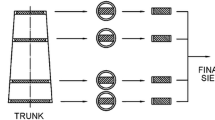Abstract
The wood of Ilomba (Pycnanthus angolensis Exell) may seriously discolor in the log after felling and also in lumber during drying. The discoloration is associated with the occurrence of bacterial metabolites. The components responsible for the discoloration were extracted completely from the wood before discoloration with hot methanol and separating into petroleum ether, diethyl ether, ethyl acetate and water soluble and insoluble fractions. Bioassays using nutrient liquids inoculated with Pseudomonas fragi revealed that the diethyl ether soluble fraction discolored most. Chemical characterization of the individual components indicated that three different types of components could be involved which are the (−)-epicatechin and (+)-catechin, the intensely red compound and the water soluble component of the methanol extracts. Their contributions to the discoloration are discussed on the basis of their colorimetric characteristics and amounts present in the wood.
Abstract
Das Holz von Ilomba (Pycnanthus angolensis Exell) kann als Rundholz nach der Fällung und auch als Schnittholz während der Trocknung beträchtlich verfärben, wobei Bakterien diese Reaktionen auslösen. Die für eine Verfärbung verantwortlichen Verbindungen wurden aus unverfärbtem Holz mit heißem Methanol extrahiert. Ihre weitere Auftrennung erfolgte mit Petroläther, Diäthyläther, Äthylacetat und Wasser, wobei ein unlöslicher Rückstand zurückblieb. Ein biologisches Prüfverfahren mit einer mit Pseudomonas fragi inkubierten Nährlösung zum Nachweis der Verfärbbarkeit der Einzelfraktionen ergab, daß im wesentlichen die Diäthylätherfraktion die gesuchten Verbindungen enthielt. Eine chemische Charakterisierung der Verbindungen zeigte, daß drei verschiedene Verbindungsarten für die Verfärbung verantwortlich sind. Es sind das (−)-Epicatechin und (+)-Catechin, eine intensiv rotfarbige und eine braune wasserlösliche Verbindung. Der Anteil dieser Verbindungen an der Verfärbung des Holzes wurde durch Photometrie und Gewichtsbestimmung ermittelt.
Similar content being viewed by others
Literature
Bauch, J.; Schmidt, O.; Yazaki, Y.; Starck, M. 1985: Significance of bacteria for the discoloration of Ilomba wood (Pycnanthus angolensis Exell) Holzforschung 39 (in press)
Dahms, K. G. 1979. Afrikanische Exporthölzer. 2. erweit. Aufl. Stuttgart: DRW-Verlag
Gottwald, H. 1958: Handelshölzer, ihre Benennung, Bestimmung und Beschreibung, Hamburg: F. Holzmann
Hillis, W. E. 1977: Secondary changes in wood. Recent advances in Phytochemistry 11:247–309
Hillis, W. E.; Yazaki, Y.; Bauch, J. 1976: The significance of anomalous extractives in heart-shakes in Dacrydium species. Wood Sci. Technol. 10:79–95.
Karstedt, P.; Liese, W.; Willeitner, H. 1971: Untersuchungen zur Verhütung von Transportschäden bei anfälligen Tropenholzarten. Holz Roh Werkstoff 29:409–415
Kennedy, J.A.; Munro, M.H.G.; Powell, H.K.; Porter, L.J.; Foo, L.Y. 1984: The protonation reactions of catechin, epicatechin and related compounds. Aust. J. Chem. 37:885–892
Shigo, A.L.; Hillis, W.E. 1973: Heartwood, discolored wood, and microorganisms in living trees. Ann. Rev. of Phytopathology 11:197–222
Starck, M. 1982; Verfärbungen von Ilombaholz (Pycnanthus angolensis Exell) bei Transport and Lagerung. Diss. Fachber. Biol., Univ. Hamburg
Starck, M.; Bauch, J.; Simatupang, M. H. 1984: Characteristics of normal and discoloured wood of Ilomba (Pycnanthus angolensis Exell). Wood Sci. Technol. 18:243–253
Wagenführ, R. 1979: Holzeigenschaftstafel Ilomba. Holztechnologie 20:2
Author information
Authors and Affiliations
Additional information
Visiting scientist from CSIRO, Division of Chemical and Wood Technology, Highett, Victoria 3190, Australia. The first author wishes to express his gratitude to the Institute for Wood Biology and to the Siemens Foundation, University of Hamburg, for a visiting Fellowship during 1982 and to Dr. W.E. Hillis, CSIRO, Melbourne to make this stay possible and for his critical reading of this manuscript. We are indebted to Dr. J. Puls and coworkers of the Institute for Wood Chemistry and Chemical Technology, BFH Hamburg, for their generous assistance and valuable discussion. We also thank Professor Dr. O. Schmidt for his contribution to the biological assessment.
Rights and permissions
About this article
Cite this article
Yazaki, Y., Bauch, J. & Endeward, R. Extractive components responsible for the discoloration of Ilomba wood (Pycnanthus angolensis Exell). Holz als Roh-und Werkstoff 43, 359–363 (1985). https://doi.org/10.1007/BF02607902
Issue Date:
DOI: https://doi.org/10.1007/BF02607902




